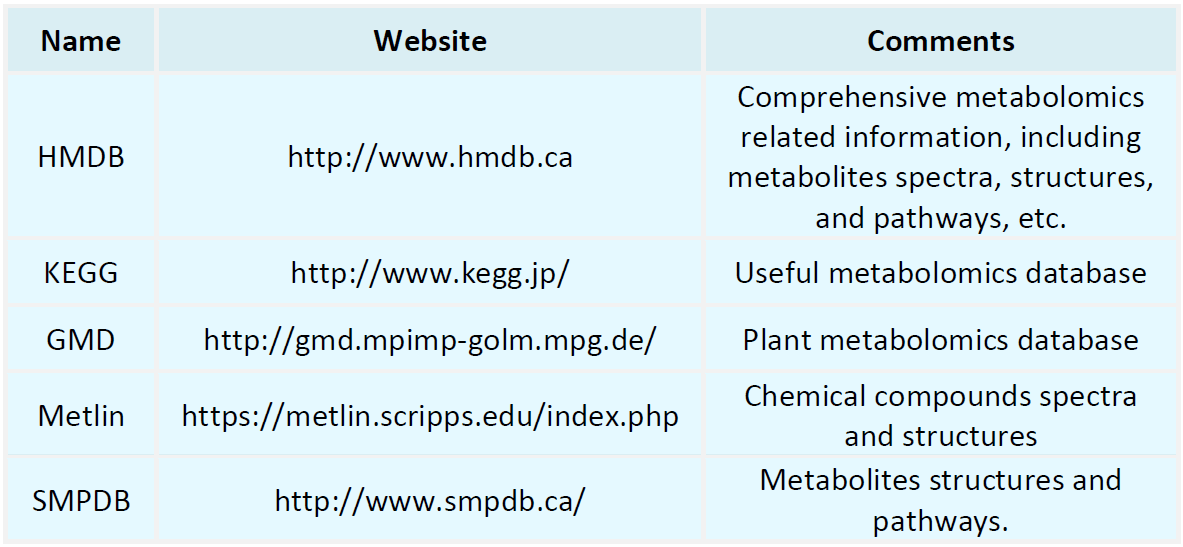Resources
Proteomics Databases

Metabolomics Databases

-
• Proteomics: Key Steps, Tools, and Best Practices
Proteomics is the scientific field that studies the composition, structure, function, and interactions of proteins within living organisms. By comprehensively analyzing the proteome, researchers can gain in-depth insights into the dynamic changes in biological systems, providing crucial information for disease research, drug development, and biomarker discovery. Proteomics not only helps understand the end products of gene expression but also reveals disease mechanisms, advancing the development of.........
-
Membrane protein analysis is a specialized area within proteomics that focuses on the investigation of proteins embedded in or associated with the cell membrane. These proteins are integral to essential biological functions, serving as receptors in signaling pathways, ion channels, transporters, and components of intercellular junctions. Given the structural complexity and dynamic nature of membrane proteins, comprehensive analysis poses significant challenges. Such analyses are crucial not only for e......
-
• MALDI-TOF Analysis of Protein
MALDI-TOF analysis of protein, also known as matrix-assisted laser desorption/ionization time-of-flight mass spectrometry (MALDI-TOF MS), is a key analytical technique in modern proteomics research. By employing a unique mass spectrometry approach, this technique enables accurate molecular weight determination of proteins and peptides. MALDI-TOF analysis of protein utilizes matrix-assisted laser desorption/ionization (MALDI) to ionize protein molecules in a sample, followed by time-of-flight (TOF) mas......
-
• Mass Spectrometry Bacterial Identification
Mass spectrometry bacterial identification is a rapid and accurate method for microbial identification leveraging mass spectrometry technology. By analyzing the protein profile of bacteria, this approach allows for the identification of bacterial species in a remarkably short time. Compared to traditional culture and biochemical testing methods, it offers superior efficiency and precision. This technique finds applications across clinical microbiology, food safety, environmental monitoring, and biopha......
-
• Label-Free Shotgun Proteomics
Label-free shotgun proteomics represents an advanced technique in proteomics analysis, notable for its independence from labeled compounds in sample quantitation. Unlike traditional labeling strategies, such as iTRAQ or SILAC, this method uses the raw signals obtained by a mass spectrometer for relative quantification. The fundamental approach involves directly digesting complex biological samples to produce peptide mixtures, which are then analyzed by high-resolution mass spectrometry to identify and......
-
Protein interface analysis is a scientific technique focused on investigating the external structure of protein molecules and their interactions with the surrounding environment. This surface is not only crucial for the protein's biological functionality but also significantly affects its interactions with drugs, ligands, and other proteins. Typically, the protein surface comprises amino acid residues exposed to the solution, and the chemical properties, spatial distribution, and dynamic changes of th......
-
• Label-Free Protein Quantification
Label-free protein quantification (LFQ) is an advanced technique for proteomics data analysis. By obtaining protein mass spectrometry data, researchers can perform relative quantification of proteins across different samples without the use of stable isotope labeling. LFQ determines the relative protein abundance in a sample by comparing the intensity and number of mass spectrometry peaks. Since this method does not require additional chemical reagents for sample processing and relies solely on the hi......
-
• Glycosylation Mass Spectrometry
Glycosylation mass spectrometry is a critical technique for analyzing glycosylation modifications in biomolecules, including proteins and lipids. Glycosylation involves attaching sugar molecules to proteins, lipids, or other molecules. Mass spectrometry fundamentally operates by ionizing molecules in a sample, then separating and detecting them based on their mass-to-charge ratio (m/z). In glycosylation mass spectrometry, biomolecules undergo processing to release sugar chains or produce peptide fragm......
-
• Hemp Protein Complete Amino Acid Profile
The analysis of the hemp protein complete amino acid profile aims to unveil its amino acid composition, facilitating the evaluation of its nutritional value and potential health benefits. The amino acid profile of hemp protein is notably balanced, encompassing all essential amino acids necessary for human health in adequate amounts, rendering it a superior plant-based protein source. This analysis provides reliable data to scientists and nutritionists, supporting a deeper understanding of hemp protein......
-
ESI-MS protein analysis has emerged as a critical tool for elucidating protein structures and functions, primarily employed in the assessment of molecular weight, structural characteristics, complex formations, and interactions with other molecules. By integrating liquid chromatography with mass spectrometry, ESI-MS facilitates the analysis of complex samples. The heart of this method is the electrospray process: a sample solution is dispensed through a capillary under high voltage, creating charged d......
How to order?







